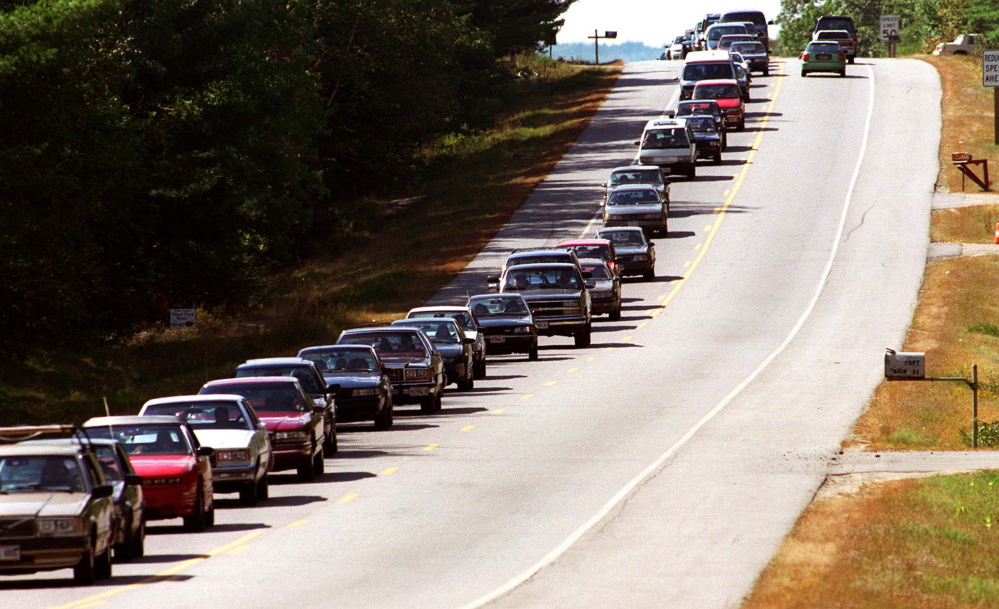Before I get up on my high horse and complain about the traffic to the Common Ground Fair in Unity last weekend, a confession: I drove there, from Portland, by myself: 194.2 miles round trip. Minus some 10 miles. (More on that later.)
I had hoped to carpool. I had tried to carpool. Attempts to catch a ride with colleagues failed; our timing didn’t sync up. I put out the word that I was looking and that I was willing to split gas and tolls. No takers. I followed a link from the MOFGA website (the fair is put on by the Maine Organic Farmers and Gardeners Association) that read, “Please consider ridesharing. Visit GoMaine for more information.”
I plugged in my coordinates on the site, which is sponsored by the state’s Department of Transportation and Turnpike Authority and designed to connect commuters as well as other drivers. I got just a single match for my time slot. I emailed Ashley, and phoned. Twice. Silence.
I did at least throw my bike on my car, intending to park at the Park & Pedal lot four miles from the fairgrounds and to take advantage of the fair’s Valet Bike Parking (!) and $2 break on the cost of admission for cyclists. You can also ride a train the last few miles to Common Ground, which the fair encourages.
Then I slid behind the wheel and headed north – an empty seat next to me, three more in back – to a fair that celebrates Maine’s agriculture and rural traditions and the ENVIRONMENT.
HERE’S THE THING
If you have ever been to the Common Ground Fair, you know what’s coming.
The traffic jam. The notorious, the inevitable, the epic traffic jam. Over three days, some 60,000 people crowd onto the roads in Unity, a town of just 2,100 people.
But this is not a tirade about sitting in traffic. It’s a tirade about sitting in traffic on the way to a renowned event that extols sustainability.
“That traffic jam is one of the biggest traffic jams in the entire state,” said Nancy Grant, executive director of the Bicycle Coalition of Maine, which organizes the fair’s Park & Pedal. “It’s kind of ironic you have all of these cars idling, in some cases for up to an hour, at an event focused on environmental sustainability.”
You said it, sister.
Aggravated (and how), I pulled out of the line of cars into a hardware store lot, where the sympathetic employees let me park for the day. I unloaded my bike, hopped on and gleefully rode the remaining five miles, zipping by many hundreds of cars, many with just one or two occupants. “Hey! Can we trade vehicles?” one woman called out from her idling car.
A GREENER WAY?
Lest you think I am churlish, let me state that I spent a magical day at this magical fair, ogling adorable sheepdogs, eating excellent fiddlehead ravioli, coveting exquisite handcrafted doodads, chatting with a biologist about Maine sedges and with a cheesemaker about the right number of cows to have.
That said, I had traffic on the brain. Cars and trucks account for more than a fifth of all U.S. global warming pollution, according to the Union of Concerned Scientists.
There has got to be a better way to reach the Common Ground Fair.
I phoned David Cole, former head of the Maine DOT and now at David Cole Consulting. How best, I asked him, to unsnarl the traffic? Though the usual solution to congestion is to build a bigger road, that scarcely seems like the right green answer. “You don’t build your way out of these kinds of things, certainly not for an annual event,” Cole said. His suggestion: better communication, both with drivers (“If a delay is 10 minutes and you are not expecting it, it feels like forever”) and with the Department of Transportation.
As it happens, the DOT was working on Route 139 at the time, which meant a short stretch of single-lane traffic near Unity; MOFGA warned drivers about the situation on the fair website. “The DOT will do the best they can,” Cole added, “but you can’t pave in January.” Both Cole and MOFGA also urged fairgoers to stagger their hours, scheduling visits for the fair’s least crowded times.
“Traffic? What traffic?” said Jim Bowers, a good-humored Common Ground volunteer who for 20 years co-coordinated parking cars at the fair and now does the same for parking bicycles (275 of them on Saturday, the busiest bike day). He explained a few of the challenges:
• The parking volunteers are just that, volunteers, not traffic control experts.
• The local sheriff’s department isn’t expert at traffic jams, either.
• The drivers like to stop and ask questions.
Plus, Bowers said, “If you get a thundershower, everybody tries to leave at the same time.”
All of this left me wondering about more out-of-the box solutions: a social media campaign for ride-sharing that really works; buses from Portland, Brunswick and Augusta with reduced price admission; or giving carpoolers discounted entrance or parking. The fair does not charge for parking now, because handling money would slow the traffic even more, Bowers pointed out, although he added that collecting money as cars leave might work.
I don’t have the answer. This year, I was part of the problem. Surely, though, there are ways to make the journey reflect the environmental ideals of the idyllic destination.
Peggy Grodinsky is editor of Source. Contact her at 791-6453 or at:
pgrodinsky@pressherald.com
Send questions/comments to the editors.



Comments are no longer available on this story